开心一刻
有一天螃蟹出门,不小心撞倒了泥鳅
泥鳅很生气地说:你是不是瞎啊!
螃蟹说:不是啊,我是螃蟹

概述
maven-shade-plugin 官网已经介绍的很详细了,我给大家简单翻译一下
This plugin provides the capability to package the artifact in an uber-jar, including its dependencies and to shade - i.e. rename - the packages of some of the dependencies.
这段话简明扼要的概述了 maven-shade-plugin 的功能
- 能够将项目连同其依赖,一并打包到一个
uber-jar中
uber-jar 就是一个超级 jar,不仅包含我们的工程代码,还包括依赖的 jar,和spring-boot-maven-plugin类似 - 能够对依赖 jar 中的包名进行重命名
这个功能就有意思了,后面我们详说
maven-shade-plugin 必须和 Maven 构建生命周期的 package 阶段绑定,那么当 Maven 执行 mvn package 时会自动触发 maven-shade-plugin;使用很简单,在 pom.xml 添加该插件依赖即可
phase 和 goal 按如上固定配置,configuration 才是我们自由发挥的平台;有了基本了解后,我们再结合官方提供的 Examples 来看看 maven-shade-plugin 具体能干啥
选择打包内容
假设我们有项目 maven-shade-plugin-demo,其项目结构如下
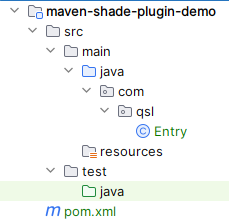
如果不做任何剔除,可以按如下配置进行全打包
执行 mvn package 后,我们会看到两个包
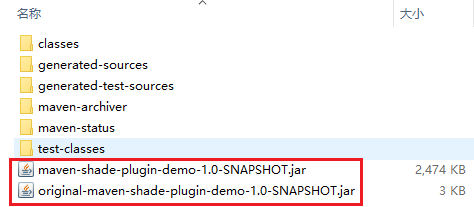
maven-shade-plugin-demo-1.0-SNAPSHOT.jar 就是 uber-jar;解压可看其结构

不仅包括 package、还包括各种配置文件、元文件,统统打包进 uber-jar;而 original-maven-shade-plugin-demo-1.0-SNAPSHOT.jar 则是不包括依赖 jar 的原始项目包;如果我们比较细心的话,会发现打包的时候告警了

意思是说 hutool jar 包中有 META-INF/MANIFEST.MF,而 maven-shade-plugin-demo 打包成 jar 后也包含 META-INF/MANIFEST.MF,两者重复了,只会将其中一个复制进 uber jar;默认情况下,是将我们项目的 jar 中的 META-INF/MANIFEST.MF 复制进 uber jar

那如果我们想保留 hutool 下的 MANIFEST.MF,而去掉 maven-shade-plugin-demo 中的 MANIFEST.MF,该如何处理呢?只需要微调下 configuration
此时 uber jar 中的 MANIFEST.MF 就来自 hutool jar 了

回到前面的 configuration 配置,我们需要明白其每个子标签的含义
filter:过滤器,可以配置多个artifact:复合标识符,用来匹配 jar,简单点说,就是匹配 jar 的匹配规则按 Maven 的坐标:groupId:artifactId[[:type]:classifier] 进行配置,groupId:artifactId必配,[[:type]:classifier]选配;支持通配符*和?,例如:<artifact>*:*</artifact>(相当于匹配上所有jar)exclude:排除项,也就是不会复制进 uber-jar;支持通配符配置include:包含项,也就是只有这些会被复制进 uber-jar;支持通配符配置
我们实战下,假设我们项目结构如下所示
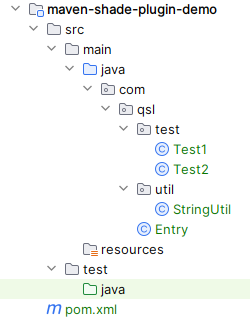
configuration 配置如下
执行 mvn package 后,uber-jar 内部结构你们能想到吗?我们来看看实际结果
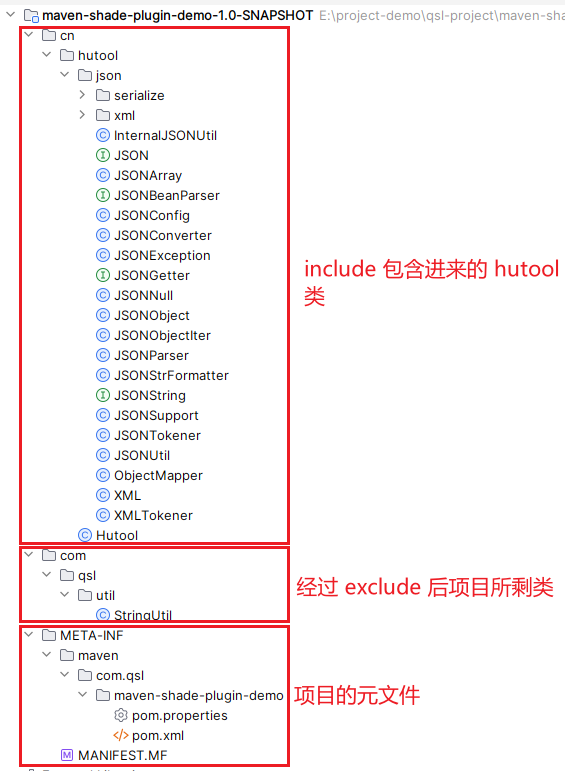
是不是和跟你们想的一样?
除了手动指定 filter 外,此插件还支持自动移除项目中没有使用到的依赖类,以此来最小化 uber jar 的体积;configuration 配置如下
我们在 StringUtil 中引入 hutool 的 StrUtil(相当于项目依赖了 StrUtil)
然后打包,uber-jar 内部结构如下所示

从 maven-shade-plugin 1.6 开始,minimizeJar 会保留 filter 中 include 配置的类,但是要注意:
inlcude 默认会排除所有不在 include 配置中的类
这就会导致问题,我们来看个案例,我们引入 logback 依赖,但代码中未用到它,而我们又想将其下的 class 复制进 uber-jar,另外我们还想将 hutool 的 cn/hutool/json 包下的全部类都复制进 uber-jar,并且开启 minimizeJar,是不是按如下配置?
打包后看 uber-jar 目录结构
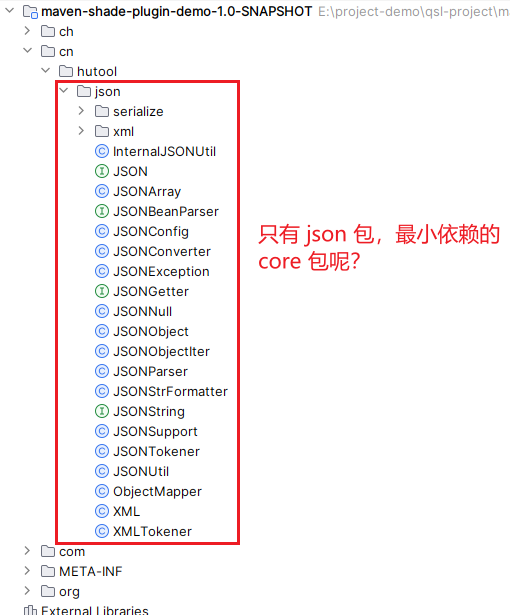
hutool 的 core 包没有复制进来,这是因为我们对 hutool 配置了 include ,默认把最小依赖的 core 包给排除掉了,那怎么办呢?插件提供了配置 <excludeDefaults>false</excludeDefaults> 来处理此种情况,它会覆盖 include 默认排除行为
这样配置之后,既能包含 hutool 的 json 包,又能包含最小依赖的 core 包
false 通常配合 true
这么配置有何意义?
重定位 class
如果 uber-jar 被其他项目依赖,而我们的 uber-jar 又是保留了依赖 jar 的 class 的全类名,那么就可能类重复而导致类加载冲突;比如项目A依赖了我们的 maven-shade-plugin-demo,还依赖了 B.jar,两个 jar 中都存在 cn.hutool.core.util.StrUtil.class,但 api 完全不一样,根据 双亲委派模型,只会成功加载其中某个 cn.hutool.core.util.StrUtil.class,那么另一个的 api 则使用不了。为了解决这个问题,插件提供了重定位功能,通过创建 class 字节码的私有副本,按新配置的 package,打包进 uber-jar
我们来看个案例,假设我们只需要 hutool 的 core 包,将其下所有的 class 按 com.qsl.core 包打包进 uber-jar,可以按如下配置
打包后 uber-jar 目录结构如下

我们来看下 uber-jar 中的 StringUtil.class
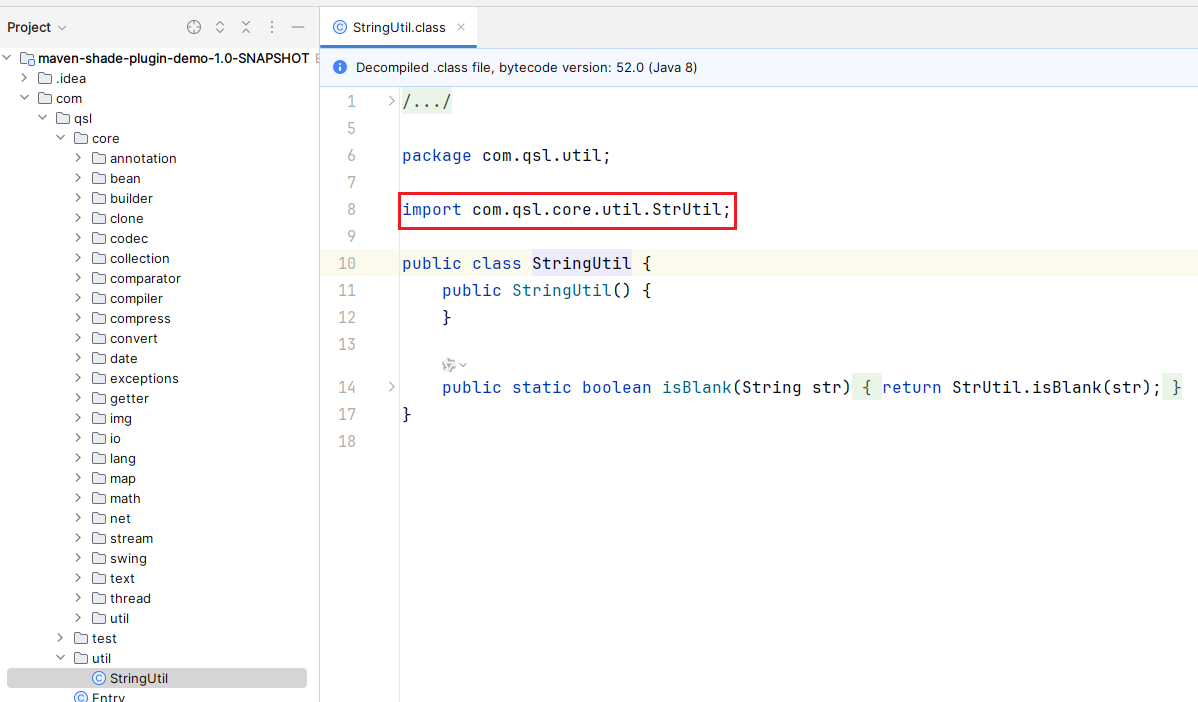
依赖的 StrUtil 也被正确调整了,是不是很牛皮?
此时项目A 依赖 B.jar 的同时,又依赖我们的 maven-shade-plugin-demo,就不会类重名了(package 不一致了)
relocation 同样支持 exclude 和 include
此时 uber-jar 的目录结构是怎样的?你们自己去试!
生成附属包
前面已经介绍过,打包后会生成两个包
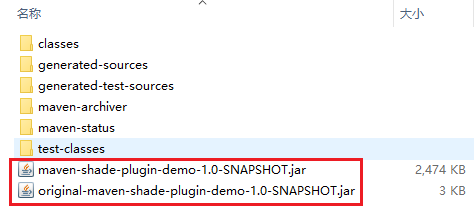
但 original 开头的那个明显不是按 Maven 坐标命名的,所以它是不能够 install 到本地或者远程仓库的;如果需要将两个 jar 都 install 到仓库中,那么就需要用到插件的 Attaching the Shaded Artifact (生成附属包)功能
部署到仓库的 jar 如下

可执行 JAR
这个就比较简单了,我们直接看配置
如上配置会将 Main-Class 写进 uber-jar 的 MANIFEST.MF,还可以通过 manifestEntries 自定义属性
打包之后,uber-jar 的 MANIFEST.MF 内容如下

资源转换器
Resource Transformers 已经介绍的很详细了,我就不一一介绍了,挑几个个人认为比较重要的简单讲一下
ServicesResourceTransformer
合并 META-INF/services/ 下的文件,并对文件中的 class 进行重定向;我们来看个例子,hutool 下有文件 cn.hutool.aop.proxy.ProxyFactory
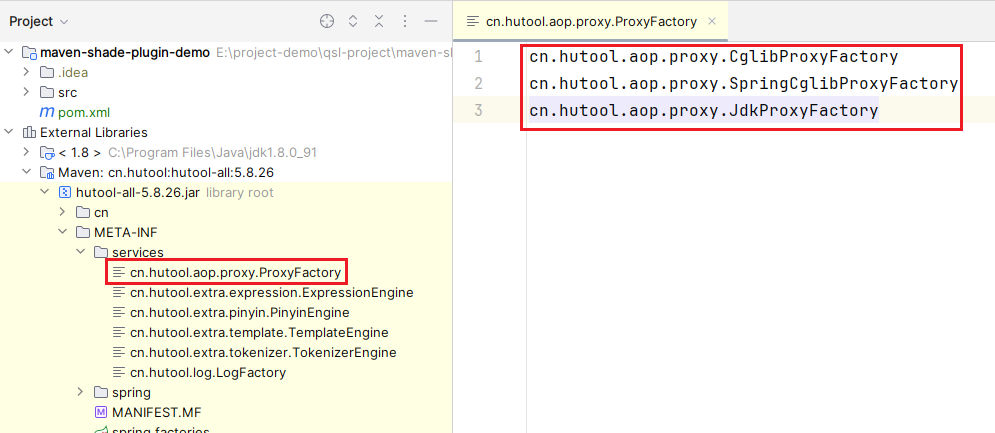
我们也自定义一个
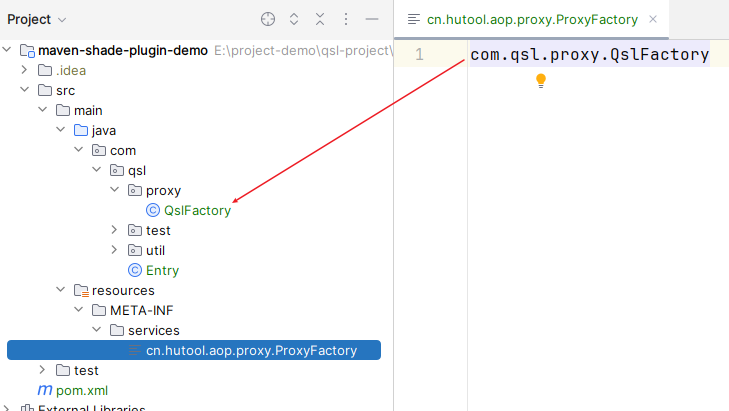
configuration 配置如下
打包后,hutool 与 uber-jar 的 cn.hutool.aop.proxy.ProxyFactory 文件内容差异如下

如果不配置 ServicesResourceTransformer,结果是怎样,你们自己去试
AppendingTransformer
将多个同名文件的内容合并追加到一起(不配置的情况下会覆盖,最终文件内容只是其中某个文件的内容),configuration 配置如下
打包后文件内容合并如下

XmlAppendingTransformer、ResourceBundleAppendingTransformer 功能类似,只是针对的文件内容格式略微有点特殊,就不演示了,你们自行去测试
同包同名 class 共存
回到我们的主题,如果我们项目依赖的 jar 中出现了同名的 class (包名和类名均相同),根据 双亲委派模型,只会加载其中某一个 class,虽然两个 class 同名了,但功能完全不一样,另一个未被加载的 class 的功能则用不了,如果想同时使用这两个同名 class 的功能,我们该如何处理?
甲方扔给两个存在包名与类名均相同的Jar包,要在工程中同时使用怎么办?
文中给出了几种解决方案(注意看评论区),最高效最实用的当属 maven-shade-plugin;假设我们项目依赖的 A.jar 和 B.jar 都存在 com.qsl.Hello.class,我们可以新建一个项目,名字叫 qsl-a,没有任何代码,仅仅依赖 A.jar,然后利用 maven-shade-plugin 的 Relocating Classes 功能对 A.jar 中存在重名的 class 进行重定向,例如
然后打包得到 uber jar(qsl-a.jar),项目依赖从 A.jar 更改成 qsl-a.jar,B.jar 依赖继续保留,那么项目中可用的 Hello.class 就包括
com.qsl.Hello(B.jar)
com.qsla.Hello(qsl-a.jar)
问题是不是就得到解决了?更实际的案例,敬请期待我下篇博客
总结
- maven-shade-plugin 的输入目标是
项目原始jar以及项目依赖的所有jar,而输出目标是uber-jar,所以 maven-shade-plugin 的规则对项目原始jar是无效的 -
minimizeJar针对的只是class,其他类型的文件不受此约束 - 同 class 共存问题,可以利用 maven-shade-plugin 的 Relocating Classes 功能,将其中一个或多个 jar 重新打包成新的 jar,保证类名相同但包名不同,然后项目依赖新的 jar,变相解决了同 class 共存问题
- 示例项目: maven-shade-plugin-demo





















 519
519

 被折叠的 条评论
为什么被折叠?
被折叠的 条评论
为什么被折叠?








